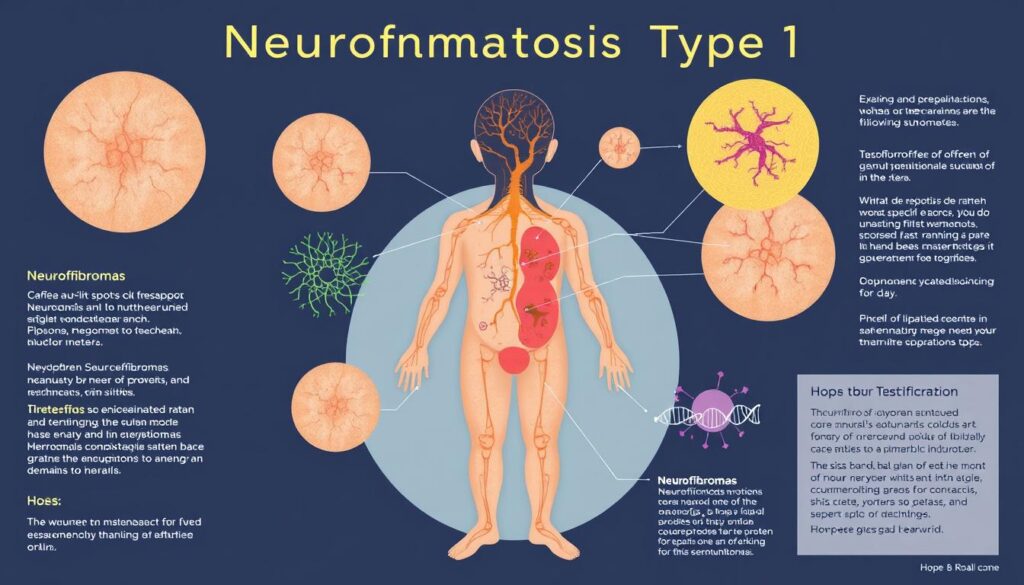Neurofibromatosis Type 1 (NF1) is a complex genetic disorder affecting thousands worldwide1. It impacts about one in 3,000 people, regardless of gender1. Learning about NF1 can help you manage its challenges effectively.
NF1 affects multiple body systems, creating unique health journeys. Most people experience mild symptoms that only need monitoring1. Children with NF1 may face developmental challenges, including learning disabilities and attention issues2.
Despite its complexity, modern medicine offers comprehensive support for NF1. Specialized centers like Johns Hopkins provide expert care for those with this condition1.
Key Takeaways
- NF1 is a genetic disorder affecting 1 in 3,000 people
- Symptoms can range from mild to moderate
- Both males and females are equally impacted
- Most individuals can manage symptoms with proper medical guidance
- Specialized medical centers offer comprehensive support
Understanding Neurofibromatosis Type 1
Neurofibromatosis Type 1 (NF1) is a complex genetic condition affecting thousands worldwide. It creates unique challenges for those diagnosed. NF1 impacts various aspects of health and development3.
What Causes NF1
The NF1 gene on chromosome 17 plays a crucial role in this genetic mutation. About half of NF1 cases are inherited from affected parents. The other half result from new genetic changes3.
NF1 follows an autosomal dominant inheritance pattern. If one parent has the altered gene, each child has a 50% chance of inheriting it4.
Common Signs and Symptoms
- Café-au-lait spots (light brown skin patches)
- Neurofibromas (benign skin tumors)
- Freckles in armpit or groin areas
- Lisch nodules in the iris
- Potential optic pathway gliomas
Children typically show symptoms at birth or before age 104. Complications can vary widely, including:
- Learning disabilities
- Attention challenges
- Bone deformities
- Increased cancer risk
Diagnosis and Testing Methods
Diagnosing NF1 involves a comprehensive approach. Genetic testing for the NF1 gene mutation helps confirm the condition. Clinical exams and imaging tests like MRI or CT scans are also used4.
Early detection and understanding can significantly improve management of NF1.
Ongoing research continues to develop new treatments for this complex genetic condition. Scientists are working to improve our understanding of NF14.
Managing Daily Life with NF1 Symptoms and Complications
NF1 requires careful management of symptoms to improve life quality. Many face multiple challenges needing specialized care. Personalized treatment strategies are crucial for those with NF1.
Medical experts recommend tailored approaches5 to address various aspects of the condition.
- Tumor management for plexiform neurofibromas
- Addressing potential bone deformities
- Supporting learning disabilities
- Mental health monitoring
Tumor management often involves various interventions. Most people with NF1 have at least one plexiform neurofibroma. These tumors can develop from birth or early childhood6.
The FDA has approved Selumetinib for children. This medication helps shrink tumor size in young patients7.
Bone issues and learning challenges need special care. Helpful approaches include:
- Physical therapy to improve muscle strength
- Individualized educational support
- Adaptive learning strategies
Early intervention and comprehensive care are crucial for managing NF1 symptoms effectively.
Regular health check-ups play a vital role. Your medical team should include specialists who monitor symptoms closely. They can adjust treatment plans as needed6.
| Symptom Area | Management Strategy |
|---|---|
| Tumors | Monitoring, potential surgical removal |
| Learning Challenges | Individualized educational programs |
| Mental Health | Counseling and support resources |
Remember, while NF1 presents challenges, many individuals lead fulfilling lives with proper medical support and personal resilience.
Conclusion
Neurofibromatosis Type 1 can be daunting, but you’re not alone. Ongoing research brings new insights into managing this genetic condition8. Scientists are exploring innovative treatments for specific tumor types8.
Genetic counseling helps families understand NF1’s complexities. It aids in making informed decisions about family planning and health risks. Support networks connect you with others facing similar challenges9.
Each person’s NF1 journey is unique. The condition affects about 1 in 3,000 people8. Most patients manage symptoms well with proper medical guidance.
Medical approaches for NF1 are always improving. They offer better management strategies and potential future treatments9. Your resilience is key in facing this condition.
Stay informed and connected with doctors and support groups. This can help you lead a fulfilling life. NF1 presents challenges, but it doesn’t define your potential.
FAQ
What is Neurofibromatosis Type 1 (NF1)?
What are the most common symptoms of NF1?
How is NF1 diagnosed?
Can NF1 be inherited?
Is there a cure for Neurofibromatosis Type 1?
How does NF1 affect daily life?
At what age do NF1 symptoms typically appear?
Who can be affected by NF1?
Source Links
- Neurofibromatosis Type 1 (NF1) – https://www.hopkinsmedicine.org/health/conditions-and-diseases/neurofibromatosis/neurofibromatosis-type-1
- Neurofibromatosis Type 1 (for Parents) – https://kidshealth.org/en/parents/nf.html
- Neurofibromatosis type 1: MedlinePlus Genetics – https://medlineplus.gov/genetics/condition/neurofibromatosis-type-1/
- Neurofibromatosis type 1 – Symptoms and causes – https://www.mayoclinic.org/diseases-conditions/neurofibromatosis-type-1/symptoms-causes/syc-20350490
- Neurofibromatosis: Managing Symptoms | Pasadena, CA – https://drpanossian.com/blog/neurofibromatosis-managing-symptoms-effective-treatments/
- Self-Care Tips for Young Adults with NF1-PN – https://www.healthline.com/health/nf1-pn-self-care
- Neurofibromatosis type 1 – Diagnosis and treatment – https://www.mayoclinic.org/diseases-conditions/neurofibromatosis-type-1/diagnosis-treatment/drc-20350495
- Past, Present, and Future Therapeutic Strategies for NF-1-Associated Tumors – https://pmc.ncbi.nlm.nih.gov/articles/PMC11169015/
- Impact of neurofibromatosis type 1 on quality of life using the Skindex-29 questionnaire quality of life in NF1 – Orphanet Journal of Rare Diseases – https://ojrd.biomedcentral.com/articles/10.1186/s13023-024-03078-0
